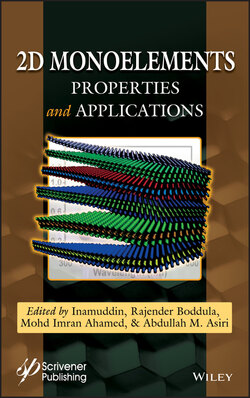Читать книгу 2D Monoelements - Группа авторов - Страница 9
Оглавление
Preface
The development of new two-dimensional (2D) monoelements-based semiconductor materials, such as phosphorene, graphene, antimonene, etc., has attracted many researchers due to their wide range of applications in diverse sectors along with their promotion of novel innovations in the field of science. Due to their impressive physical, chemical, electronic, and optical properties these 2D monoelements have been identified as potential agents for a variety of applications such as electronics, theranostics, therapeutic delivery, bioimaging, sensors, field-effect transistors, the environment, energy conversion, storage, etc.
This edition of Monoelements: Properties and Applications explores the basic idea of 2D monoelements, classifications, and application in field-effect transistors for sensing and biosensing. Finally, various challenges, future developments, and research progress are also discussed. This book will be useful for beginners and experts—from undergraduate students to industrial engineers—working in the area of semiconductors, materials science, and engineering. Based on thematic topics, this edition contains the following eleven chapters:
Chapter 1 investigates recent advances in phosphorene. In particular, the effects of its strong anisotropy and its high reactivity on the physical properties of pure and functionalized phosphorene are discussed in detail. This largely distinguishes phosphorene from other 2D materials and makes it the ideal platform for emerging devices.
Chapter 2 provides insights into the recent exploration of the diverse properties of 2D antimonene, continuous updating of preparation methods, as well as further development of potential applications, and then looks ahead to the opportunities and challenges facing antimonene in the future.
Chapter 3 presents a brief review of graphene and its derivatives. Applications of graphene and graphene oxide in the electronic and biomedical fields are discussed, and their physical properties like thermal and electrical properties are outlined.
Chapter 4 discusses the molecular docking simulation study used to analyze the binding mechanisms of graphene oxide as a cancer drug carrier.
Chapter 5 aims to group the significant work reported in the last few years on metal-organic frameworks (MOFs)-derived carbon (graphene and carbon nanotubes) and MOF-carbon composite materials, with a special emphasis on the use of these nanostructures for energy storage devices (supercapacitors).
Chapter 6 summarizes the basic idea of 2D classification like graphene application in field-effect transistors for sensing and biosensing. These 2D monoelements have been identified as potential agents for a variety of applications such as theranostics, therapeutic delivery, bioimaging, gas sensors, biosensors, field-effect transistors, semiconductors, etc.
Chapter 7 describes various graphene-based ternary materials as a super-capacitor electrode. Different forms of functionalized graphene are discussed, including graphene oxide and reduced graphene oxide and its characteristic properties. A main focus of this chapter is the synthesis and electrochemical features of various graphene-based ternary composites with conducting polymer, metal oxide and other carbon-based materials.
Chapter 8 explains the physico-chemical properties such as electronic band structure, electrochemical influence of graphene doping, and chemistry behind graphite exfoliation. Furthermore, it extends to electrochemical sensing of analytes such as glucose, DNA and aptamer, pollutants, gas, pharmaceutics, and antioxidants.
Chapter 9 describes the structures, fundamental properties, and applications of germanene and aims to draw the attention of researchers towards the possibilities offered by the use of germanene-based materials for improving their working characteristics and for replacing rather expensive traditional materials used in energy storage devices.
Chapter 10 discusses the fundamental milestones of graphene origin, synthesis routes, advantages, and various literature cites toxicity studies. The role of 2D graphene in gene-delivery, tissue-engineering, prosthetic-implants, cancer-therapy, and biosensing fields are explored as well. The major arena of focus is ascribed to in vivo and in vitro studies of graphene for biomedical use.
Chapter 11 describes graphene and graphene-based materials for energy devices. The chapter broadly discusses the role of graphene as electroactive anode and cathode materials with major focus on lithium ion batteries and supercapacitors. The chapter also includes basic synthesis and characterization techniques.
EditorsInamuddinRajender Boddula Mohd Imran Ahamed Abdullah M. Asiri September 2020
